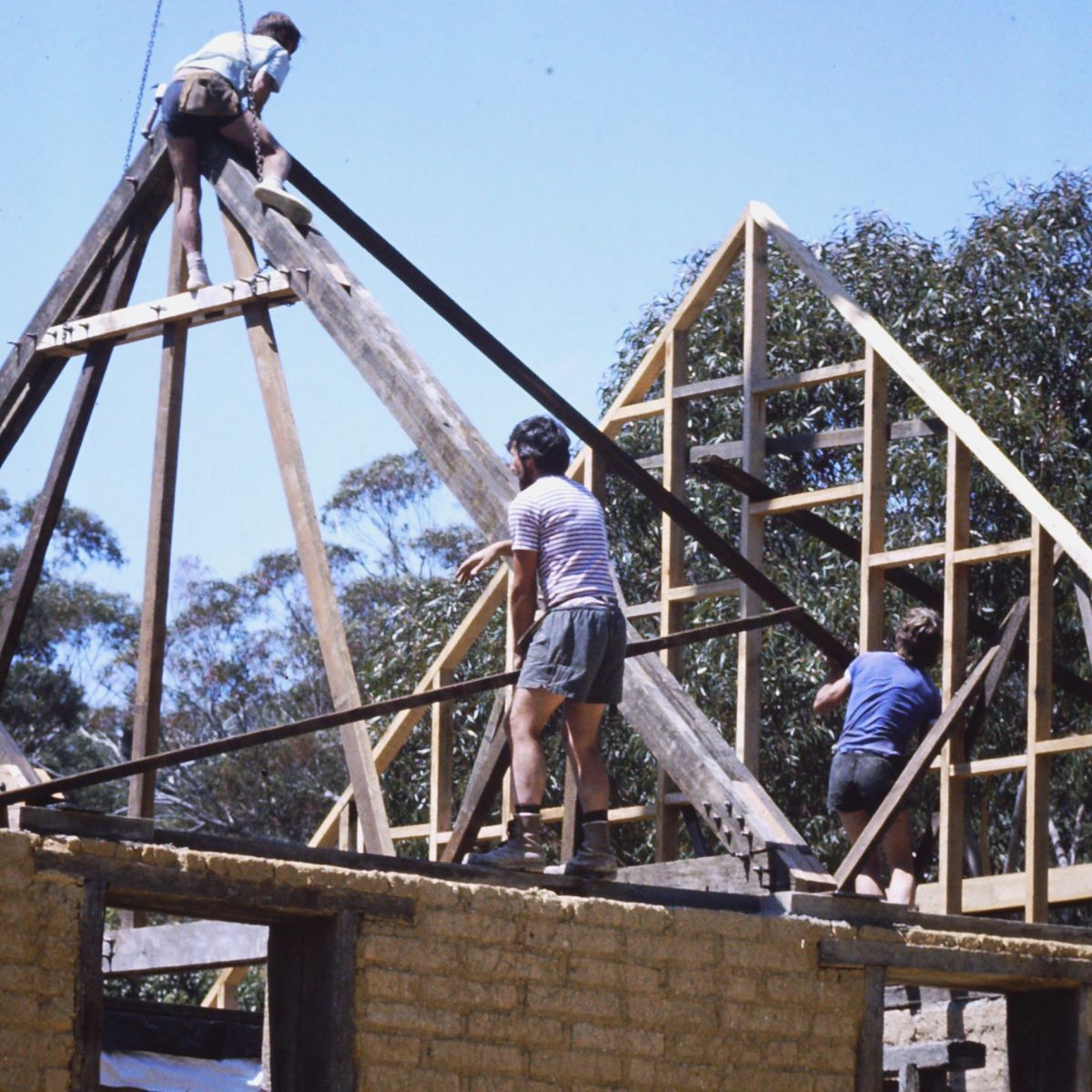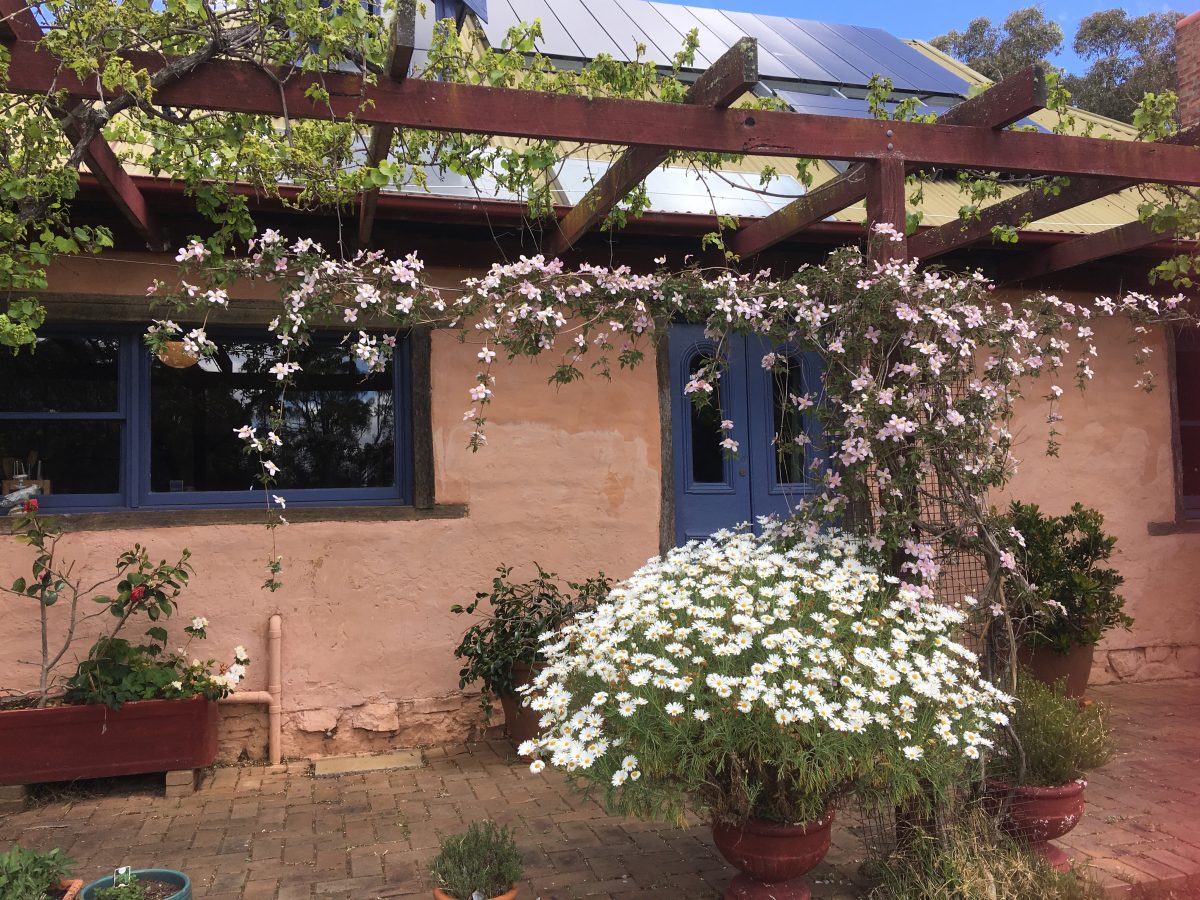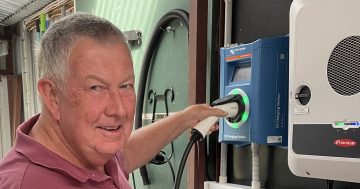
Ron Smith, John Egan and Tony Egan building the framework of a mud-brick home. Photo: Karen Egan.
Tiyces Lane east of Goulburn is changing from grazing properties into a small rural/residential community. Off the Hume Highway wending through undulating bushland, the lane has been sparsely populated with homes – until recently.
Country mansions dominate numerous farmlets with horses and llamas. Fruit orchards and veggie gardens are blossoming, some fully enclosed against invading rabbits, wombats, kangaroos and cockatoos.
Among the early arrivals from Sydney more than 40 years ago, Tony and Karen Egan built a mud-brick home with a prominent arched roof eight kilometres along Tiyces Lane.
Captivated by the area’s natural beauty, Tony named the 50-acre property Koongarra after working many years earlier at a remote campsite in the Northern Territory which he regarded as the most beautiful place on Earth. Strewn with Aboriginal artefacts, the camp was between the Koongarra and Arnhem Land escarpments.
Tony and Karen overcame planning and access hurdles before completing their mud-brick home. They joined other newcomers over the years fighting off quarrying businesses and an attempt along Tiyces Lane to establish the largest mushroom compost factory in the Southern Hemisphere, which aimed to process 5000 tonnes of compost a week.
The struggles have been rewarded, Tony said. “Being in a natural environment in Australia, we see kangaroos all the time and wombats and echidnas. We lease a block beside us from the State Government, to protect the native flora and fauna and there are lyre birds there.”
Threatening bushfires and the swiftly changing elements of their rural lifestyle inspired Karen, a diverse and accomplished artist and teacher, to feature them in public exhibitions.
Now the Egans are leaving Tiyces Lane and moving into Goulburn, with wonderful memories of taking a less-travelled path while raising their two children Alice and Tom.
Etched in those memories is building the structural engineer-designed mud-brick home. They had learned from friends who made similar homes, experimented with their bricks and checked with the CSIRO to get their mixture of clay, sand, straw and water just right.
Helped by his brother John, Tony, and Karen did much of the labour on the house. They employed carpenter Ron Smith who later opened a traditional joinery business in Goulburn.
In winter they found once their slow combustion fuel stove heated water-filled radiators, the home stayed warm thanks to the thick walls. “Same in summer, it’s cool inside, even when it is stinking hot outside, it holds its temperature very well,” Tony said. They surrounded the house with sprinklers and on the roof ridge in case of bushfire.

Experimenting, testing, and finding new sources of clay were needed to make several thousand bricks for the Egans’ home. Photo: Karen Egan.
“We used railway sleepers for all the surrounds of our windows and doors,” Tony said. “Most are ironbark, you would need a flame thrower to get them to start burning.”
John Egan and his wife Lyn also built a home along Tiyces Lane, into the side of a hill, with soil on the top of each level. Both doctors, the couple later moved into town to be on hand for emergency call-outs.
After several years, Tony and Karen moved into their completed home in 1985. They asked the then Southern Tablelands County Council about power access, and were quoted $86,000 for the necessary connection. Instead, they relied first on kerosene lamps and fridges, then gas lamps and fridges while Tony studied what then was the early days of solar power.
“I realised nobody around here had a background or experience in solar power,” he said. He established The Energy Shop in Goulburn at a time of few retail outlets. “In those days we [solar industry colleagues] would have meetings and there would be 25 people from all over Australia, that was the sum of the industry, basically,” he said. “Nowadays if you had a meeting like that you would have 20,000 people working with businesses purely in solar technology.”
He closed The Energy Shop in 2012 and later worked for Goulburn Solar, and now helps people live off-grid.

No place like home – the completed mud-brick home which became a welcome retreat for the Egans. Photo: Karen Egan.
Some years ago his son Tom was doing a science degree at Sydney University, when a lecturer remarked solar energy was good for powering up calculators, but you could not run a house on one.
“Tom put up his hand and said, ‘That’s all I had all my life, we run the whole house with solar panels’,” Tony said. A couple of fridges, computers, washing machines, toasters and air conditioning all running on the power of the sun made life easier along Tiyces Lane.








